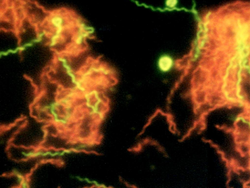| Spirochaetales | |
|---|---|
 | |
| A microscopic photograph of fluorescent-stained Spirochaeta americana | |
| Scientific classification | |
| Domain: | Bacteria |
| Kingdom: | Pseudomonadati |
| Phylum: | Spirochaetota |
| Class: | Spirochaetia |
| Order: | Spirochaetales Buchanan 1917 [1] (Approved Lists 1980) [2] |
| Families | |
The Spirochaetales are an order of spirochete bacteria. Some species within this order are known to causes syphilis, Lyme disease, relapsing fever, and other illnesses. [3]